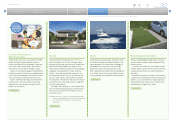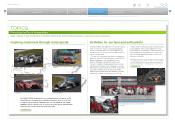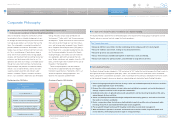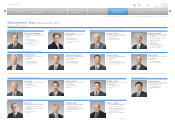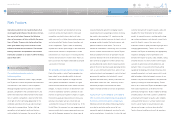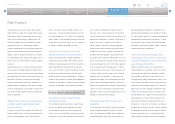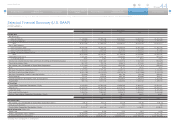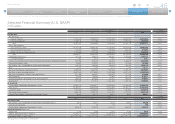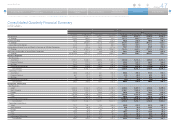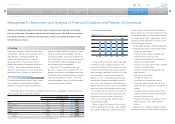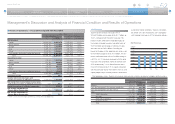Toyota 2014 Annual Report Download - page 42
Download and view the complete annual report
Please find page 42 of the 2014 Toyota annual report below. You can navigate through the pages in the report by either clicking on the pages listed below, or by using the keyword search tool below to find specific information within the annual report.
ANNUAL REPORT 2014
President’s MessagePresident’s Message
Overview of
Four Business Units
Overview of
Four Business Units
Special FeatureSpecial Feature
Review of OperationsReview of Operations
Consolidated Performance
Highlights
Consolidated Performance
Highlights
Management and
Corporate Information
Management and
Corporate Information
Investor InformationInvestor Information
Financial SectionFinancial Section
Page 42
NextPrev
ContentsSearchPrint
Risk Factors
may decrease, adversely affecting its financial condi-
tion and results of operations.
Toyota relies on suppliers for the provision of
certain supplies including parts, components and
raw materials.
Toyota purchases supplies including parts, compo-
nents and raw materials from a number of external
suppliers located around the world. For some
supplies, Toyota relies on a single supplier or a limited
number of suppliers, whose replacement with another
supplier may be difficult. Inability to obtain supplies
from a single or limited source supplier may result in
difficulty obtaining supplies and may restrict Toyota’s
ability to produce vehicles. Furthermore, even if Toyota
were to rely on a large number of suppliers, first-tier
suppliers with whom Toyota directly transacts may in
turn rely on a single second-tier supplier or limited
second-tier suppliers. Toyota’s ability to continue to
obtain supplies from its suppliers in a timely and cost-
effective manner is subject to a number of factors,
some of which are not within Toyota’s control. These
factors include the ability of Toyota’s suppliers to
provide a continued source of supply, and Toyota’s
ability to effectively compete and obtain competitive
prices from suppliers. A loss of any single or limited
source supplier or inability to obtain supplies from
suppliers in a timely and cost-effective manner could
lead to increased costs or delays or suspensions in
Toyota’s ability to market and distribute effectively
is an integral part of Toyota’s successful sales.
Toyota’s success in the sale of vehicles depends on its
ability to market and distribute effectively based on
distribution networks and sales techniques tailored to
the needs of its customers. There is no assurance that
Toyota will be able to develop sales techniques and
distribution networks that effectively adapt to changing
customer preferences or changes in the regulatory
environment in the major markets in which it operates.
Toyota’s inability to maintain well-developed sales
techniques and distribution networks may result in
decreased sales and market share and may adversely
affect its financial condition and results of operations.
Toyota’s success is significantly impacted by its
ability to maintain and develop its brand image.
In the highly competitive automotive industry, it is criti-
cal to maintain and develop a brand image. In order to
maintain and develop a brand image, it is necessary to
further increase customers’ confidence by providing
safe, high-quality products that meet customer prefer-
ences and demand. If Toyota is unable to effectively
maintain and develop its brand image as a result of its
inability to provide safe, high-quality products or as a
result of the failure to promptly implement safety
measures such as recalls when necessary, vehicle unit
sales and/or sale prices may decrease, and as a result
revenues and profits may not increase as expected or
Toyota’s production and deliveries, which could have
an adverse effect on Toyota’s financial condition and
results of operations.
The worldwide financial services industry is highly
competitive.
The worldwide financial services industry is highly
competitive. Increased competition in automobile
financing may lead to decreased margins. A decline in
Toyota’s vehicle unit sales, an increase in residual
value risk due to lower used vehicle price, an increase
in the ratio of credit losses and increased funding
costs are factors which may impact Toyota’s financial
services operations. If Toyota is unable to adequately
respond to the changes and competition in automo-
bile financing, Toyota’s financial services operations
may adversely affect its financial condition and results
of operations.
Toyota’s operations and vehicles rely on various
digital and information technologies.
Toyota depends on various information technology
networks and systems, some of which are managed
by third parties, to process, transmit and store elec-
tronic information, including sensitive data, and to
manage or support a variety of business processes
and activities, including manufacturing, research and
development, supply chain management, sales and
accounting. In addition, Toyota’s vehicles may rely on
various digital and information technologies, including
information service and driving assistance functions.
Despite security measures, Toyota’s digital and infor-
mation technology networks and systems may be
vulnerable to damage, disruptions or shutdowns due
to attacks by hackers, computer viruses, breaches
due to unauthorized use, errors or malfeasance by
employees and others who have or gain access to the
networks and systems Toyota depends on, service
failures or bankruptcy of third parties such as software
development or cloud computing vendors, power
shortages and outages, and utility failures or other
catastrophic events like natural disasters. Such
incidents could materially disrupt critical operations,
disclose sensitive data, interfere with information
services and driving assistance functions in Toyota’s
vehicles, and/or give rise to legal claims or proceed-
ings, liability or regulatory penalties under applicable
laws, which could have an adverse effect on Toyota’s
brand image and its financial condition and results of
operations.
N Financial Market and Economic Risks
Toyota’s operations are subject to currency and
interest rate fluctuations.
Toyota is sensitive to fluctuations in foreign currency
exchange rates and is principally exposed to fluctua-
tions in the value of the Japanese yen, the U.S. dollar
R&D and Intellectual Property Corporate Philosophy Corporate Governance Management Team Risk Factors [2 of 3]


